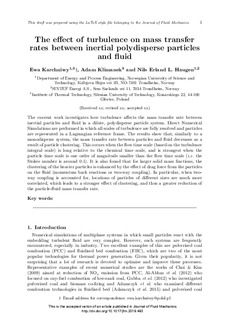| dc.contributor.author | Karchniwy, Ewa Malgorzata | |
| dc.contributor.author | Klimanek, Adam F. | |
| dc.contributor.author | Haugen, Nils Erland L | |
| dc.date.accessioned | 2020-02-10T12:09:45Z | |
| dc.date.available | 2020-02-10T12:09:45Z | |
| dc.date.created | 2019-10-28T09:30:20Z | |
| dc.date.issued | 2019 | |
| dc.identifier.citation | Journal of Fluid Mechanics. 2019, 874 1147-1168. | nb_NO |
| dc.identifier.issn | 0022-1120 | |
| dc.identifier.uri | http://hdl.handle.net/11250/2640696 | |
| dc.description.abstract | The current work investigates how turbulence affects the mass transfer rate between inertial particles and fluid in a dilute, polydisperse particle system. Direct numerical simulations are performed in which all scales of turbulence are fully resolved and particles are represented in a Lagrangian reference frame. The results show that, similarly to a monodisperse system, the mass transfer rate between particles and fluid decreases as a result of particle clustering. This occurs when the flow time scale (based on the turbulence integral scale) is long relative to the chemical time scale, and is strongest when the particle time scale is one order of magnitude smaller than the flow time scale (i.e. the Stokes number is around 0.1). It is also found that for larger solid mass fractions, the clustering of the heavier particles is enhanced by the effect of drag force from the particles on the fluid (momentum back-reactions or two-way coupling). In particular, when two-way coupling is accounted for, locations of particles of different sizes are much more correlated, which leads to a stronger effect of clustering, and thus a greater reduction of the particle-fluid mass transfer rate. © 2019 Cambridge University Press. | nb_NO |
| dc.language.iso | eng | nb_NO |
| dc.publisher | Cambridge University Press | nb_NO |
| dc.title | The effect of turbulence on mass transfer rates between inertial polydisperse particles and fluid | nb_NO |
| dc.type | Journal article | nb_NO |
| dc.type | Peer reviewed | nb_NO |
| dc.description.version | acceptedVersion | nb_NO |
| dc.source.pagenumber | 1147-1168 | nb_NO |
| dc.source.volume | 874 | nb_NO |
| dc.source.journal | Journal of Fluid Mechanics | nb_NO |
| dc.identifier.doi | 10.1017/jfm.2019.493 | |
| dc.identifier.cristin | 1741014 | |
| dc.description.localcode | © 2019. This is the authors' accepted and refereed manuscript to the article. The final authenticated version is available online at: https://doi.org/10.1017/jfm.2019.493 | nb_NO |
| cristin.unitcode | 194,64,25,0 | |
| cristin.unitname | Institutt for energi- og prosessteknikk | |
| cristin.ispublished | true | |
| cristin.fulltext | postprint | |
| cristin.qualitycode | 2 | |
